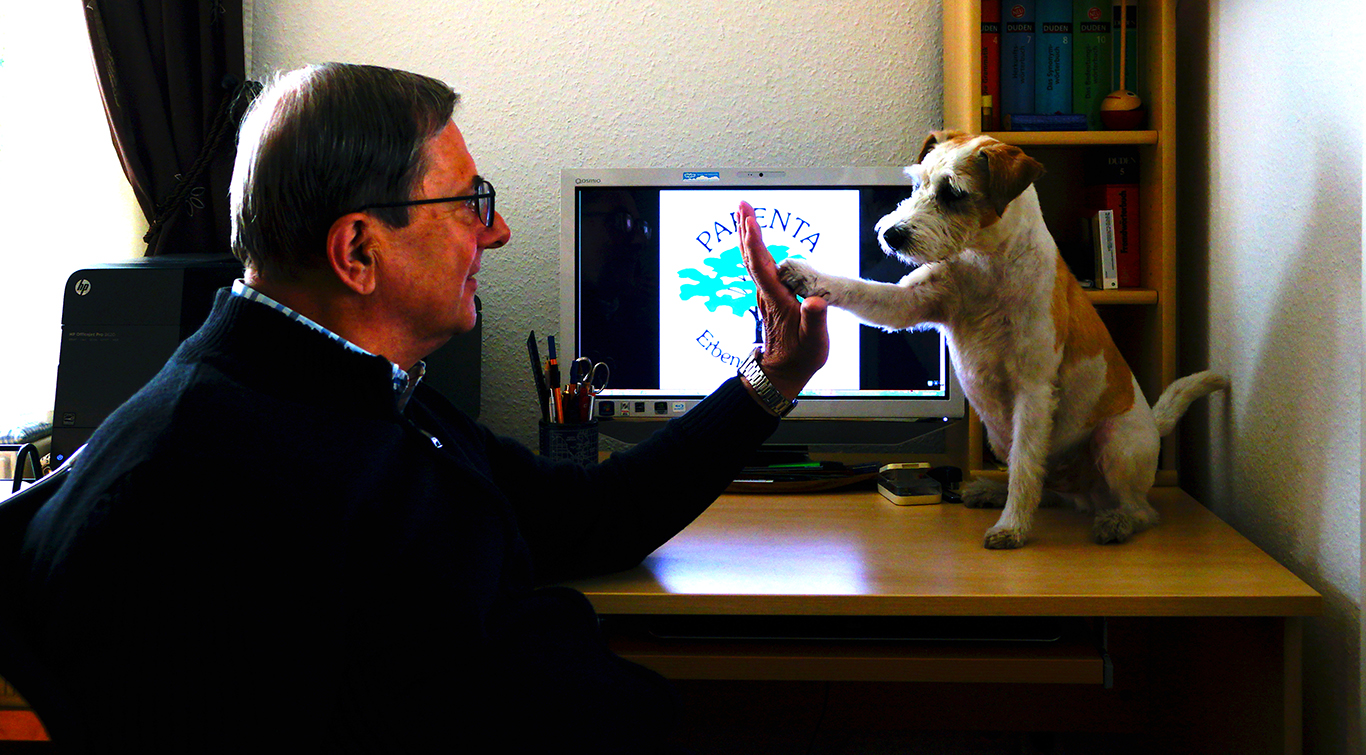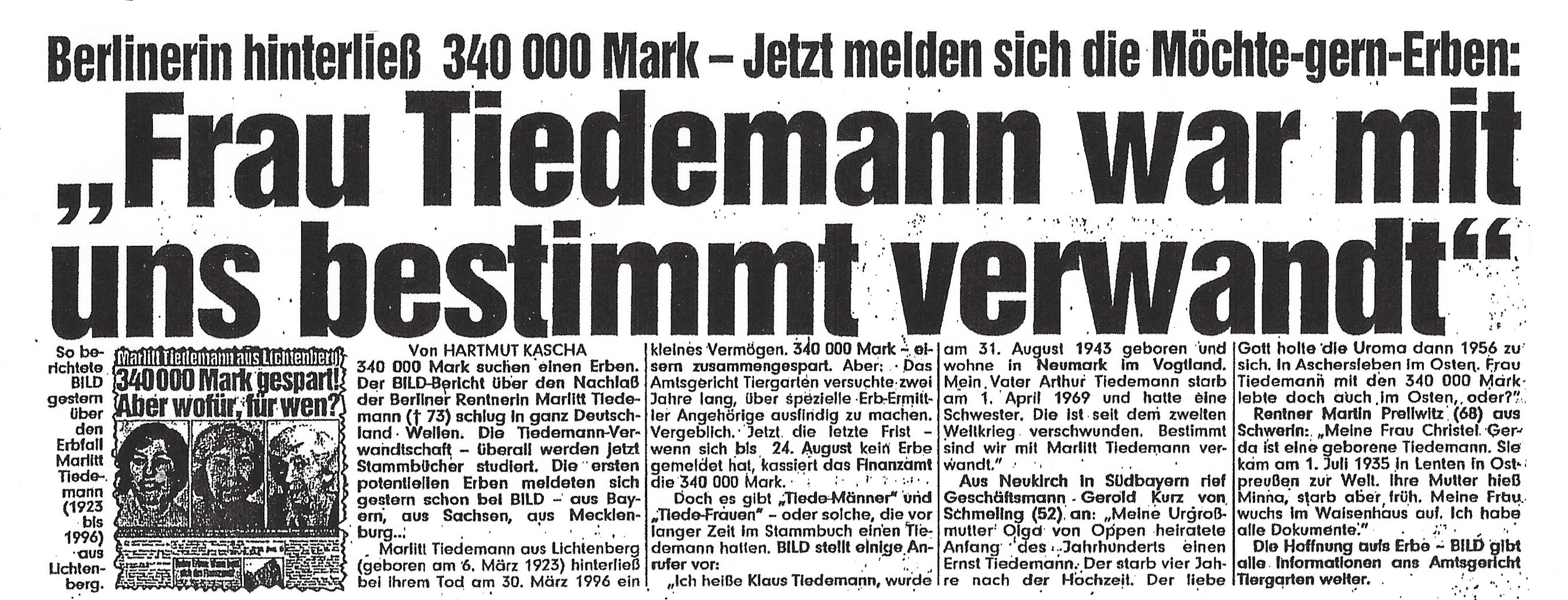PARENTA Erbenermittlung
Peter Birkholz
is a small bureau in Berlin, which can be likened to a piccolo flute in a huge orchestra. But ever since the commercial heir tracing business came into being, the flute has been a full-fledged member of the woodwind instruments section. It even gets to play solo parts now and then. And that’s how it is with us: especially when it comes to solving particularly intricate problems and when manpower alone is not a guarantee of success, we, the minor league players, score really well – as PARENTA, we have been quite successful for over twenty years now.

Turning Point
In the mid-1990s, the size and number of heir tracers in Germany was still relatively small, and conditions were equal for all. Unresolved cases were reported in the local press and in BUNDESANZEIGER (Federal Gazette); anyone could offer their services to the probate courts or their heir tracers. But in the end, it was the one who was first to find the solution to all problems and to meet all requirements who walked away with the laurels. As to the fee, according to the law, what counts is not the effort invested, but solely the result achieved.
For instance, the search for the heirs of a „Marlitt Tiedemann from Lichtenberg“ appeared on the front page of the newspaper BILD on July 29, 1998: „saved 340,000 marks! But what for and for whom?“ Apart from long-established firms, there are also a number of young companies, who are trying to answer this question: Recently, the court record listed 18 bureaus and funeral homes across the country from Schleswig down to the southern tip of the Federal Republic, and at the end, we came out in the lead. Today, there are more than 100 bureaus and funeral homes of different legal forms working in a completely different cultural setting.

Unsolvable cases
Successes such as that scored in the probate case of Tiedemann have most certainly resulted in the fact that the quality and speed of our work has come to be well-regarded, something that, over time, is also reflected by the rising number of processing offers. The cases that we have brought to a successful conclusion occasionally also include some that appeared insoluble, but which we, through disciplined and diligent work and determination, have managed to solve.
For instance, in one probate case, in which the heirs who were known to the courts, had failed, despite support from specialist lawyers, sufficiently to substantiate their claim over a period of eight years, we closed the gaps using alternative supporting documents whose evidentiary force was equivalent to that of official documents and which the court accepted as expected. But when things seemed to have reached a dead end in a clade, a Y chromosome test across four generations (as it were, a paternity test), was organised with an institute specialising in such matters. With the aid of a scientific expert opinion, it was demonstrated to the court’s satisfaction that two of the gentlemen concerned from Berlin and Baden Wuerttemberg were consanguineous via a great grandparents couple, which saved the claims of the entire clade.
Another case that was also of historical interest, was that of a testator stemming from West Prussia. despite being not even 13 years old, the youth was of an impressive build. During WWII in the spring of 1945, he had failed to return home after being evacuated in the spring of 1945 to an area thought to be less at risk of aerial bombing. Instead, he was recruited as a military helper at an air base near Ribnitz in Mecklenburg. He had made himself or others helped him (?) look two years older. Decrees issued in 1942 by the police chief in Graudenz and the governor of Marienwerder resulted in his changing his Polish family and given names to their German versions. After his release from a British prisoner of war camp, this man then lived de facto for almost 70 years under a false identity in Rhineland, while as a result of a ruling by Polish courts, the personal details of the other members of the family were changed back to their original form as recorded on the birth certificate.

It was tragic for the testator and his family that all efforts to find out one another’s fate came to nought, the last attempt having been made via the Polish Red Cross by the mother one year before her death. And this is understandable, given that at that point, finding the Polish nephew of the testator was far more important than the inheritance itself.
It takes a bit of luck too
For all the talent, skill and due diligence, it also takes quite a bit of luck to be successful in our line of work. Conversely, this also applies to the heirs, who are initially unknown or uncertain to be traced at all via statutory succession (Section1960 of the Civil Code). It is estimated that this is the case with less than two percent of our contemporaries, which is also probably why in most cases, knowledge of commercial heir tracing is limited and why heir tracers, like salesmen at the door, are often viewed with reservation and even prejudice.
Establishing contact, usually by phone, makes it possible to provide comprehensive information and to answer questions. For details and answers to FAQs, please check out the extensive store of information on the internet and especially Verband Deutscher Erbenermittler e. V. (VDEE), where our answers to frequently asked questions are provided by many colleagues with years of professional experience.
Bad advice can prove expensive
The idea of seeking legal advice to clarify matters regarding inheritance is obvious, and we certainly recommend this. But please bear in mind that, unfortunately, what applies with regard to the level of knowledge in the field of commercial heir tracing in the population at large also applies to lawyers in particular. And if the lawyer has no knowledge in this field, and is not prepared to familiarise himself with the legal principles and the relevant jurisprudence up to the Higher Regional Court and the Federal Supreme Court, quick decisions often result in even greater uncertainty. For this reason, we can only repeat our advice time and again to those concerned to find out about estate curators at the local court’s department of estates and legacies, most of whom are also lawyers. It would be unfortunate for you, and– of course, also for ourselves –if bad advice prevented you from asserting your vested right to claim an inheritance, whatever its amount.
Our credo
We create the necessary relationship of trust mainly through the convincing results of our work, some of which can be verified by those concerned and which naturally go far beyond their own knowledge regarding their family. Thus, when contacting a potential heir, we know the legal context concerning the succession. But what we do not know in our heir tracing repertoire is the request (e.g. to so called name bearers) to provide particulars, using a questionnaire, about family members, and while they are at it, also to procure the requisite supporting documents. This would doubtlessly save time and costs, but it would also often affect others who are not involved at all, raising expectations that cannot be met.
On the connection between quality and success
Another thing we take pride in is that in over 20 years of work, until now, all applications for inheritance certificates based on the results of our work have been granted.
Who is among the beneficiaries at the end of the process and what his or her share will be cannot be disclosed until the investigation is completed. And in the end, it’s the court alone that decides about who the heirs are and that confirms the claims (quotas) by issuing the certificate of inheritance. In any case, we can guarantee extensive information on the family history of those concerned. Experience has shown that this often motivates people to delve deeper into the exciting field of genealogy. We wish you good luck and much success!
